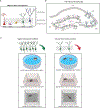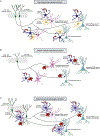Adult Neurogenesis, Glia, and the Extracellular Matrix
- PMID: 31051133
- PMCID: PMC7961263
- DOI: 10.1016/j.stem.2019.03.023
Adult Neurogenesis, Glia, and the Extracellular Matrix
Abstract
In the adult mammalian hippocampus, new neurons arise from stem and progenitor cell division, in a process known as adult neurogenesis. Adult-generated neurons are sensitive to experience and may participate in hippocampal functions, including learning and memory, anxiety and stress regulation, and social behavior. Increasing evidence emphasizes the importance of new neuron connectivity within hippocampal circuitry for understanding the impact of adult neurogenesis on brain function. In this Review, we discuss how the functional consequences of new neurons arise from the collective interactions of presynaptic and postsynaptic neurons, glial cells, and the extracellular matrix, which together form the "tetrapartite synapse."
Keywords: adult neurogenesis; astrocytes; extracellular matrix; hippocampus; immature neuron; microglia; perineuronal nets; progenitor cell; stem cell.
Copyright © 2019 Elsevier Inc. All rights reserved.
Figures




References
-
- Ambrogini P, Lattanzi D, Ciuffoli S, Betti M, Fanelli M, and Cuppini R (2013). Physical exercise and environment exploration affect synaptogenesis in adult-generated neurons in the rat dentate gyrus: possible role of BDNF. Brain Res 1534, 1–12. - PubMed
Publication types
MeSH terms
Grants and funding
LinkOut - more resources
Full Text Sources

